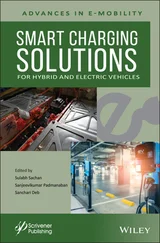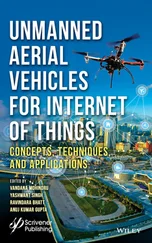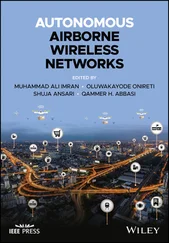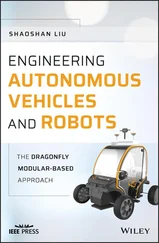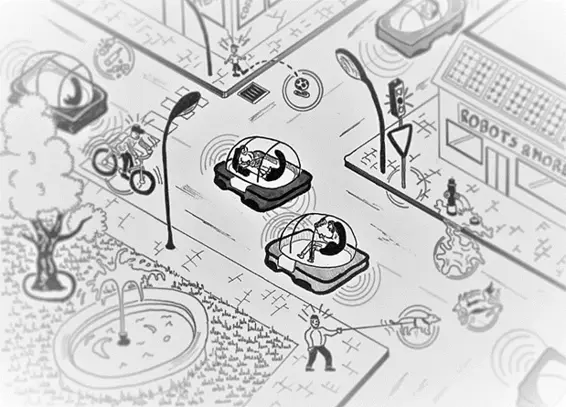
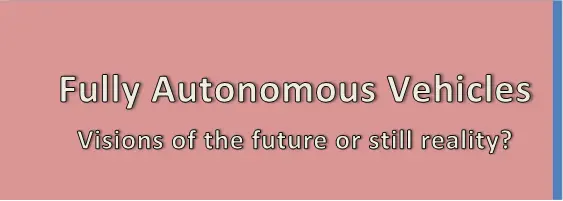


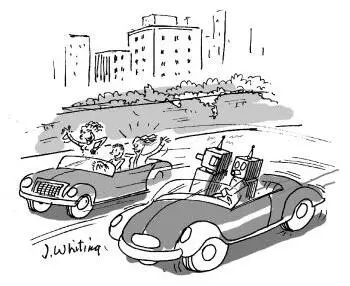
"They shouldn't allow humans to drive!"
(Image Credit: Space machine, 2015)
| The revolution, when it comes, will be engendered by the advent of autonomous or “self-driving” vehicles. And the timing may be sooner than you think. |
(Source: Center for Automotive Research, 2013 [1])
IMPRINT
Editor and Author:
Ing. Michael Nikowitz, MSc.
Fernkorngasse 54/1/310
1100 Vienna, Austria
michael.nikowitz@gmx.at
Illustration, Layout and Design:
Image courtesy of Creative Quantum Jumps by Michael Nikowitz www.creativequantumjumps.com
Copyright © Nikowitz 2015
This work is subject to copyright. All rights are reserved by the publisher, whether the whole or part of the material is concerned, specifically the rights of translation, reprinting, reuse of illustrations, recitation, broadcasting, reproduction or microfilms or in any other physical way, and transmission or information storage and retrieval, electronic adaption, computer software, or by similar or dissimilar methodology now known or hereafter developed.
The author and the editor are safe to assume that the advice and information in this book are believed to be true and accurate at the date of publication. Neither the author nor the editor give a warranty, express or implied, with respect to the material contained herein or for any errors or omissions that may have been made.
About the author
Michael Nikowitz was born in Vienna (Austria), in 1986.
From an early age, he was interested in the field of technique.
After he finished secondary technical school with a focus on mechatronics and automation, he graduated from the University of Applied Sciences (Technikum Wien) in 2011, with a Master of Science in Engineering in the field of Mechatronics and Robotics.
After working in the field of industrial and mobile robots, he changed his fields of interest to mechatronic concepts and technical optical systems.
After several years of working as a laser engineer in the field of ultrashort pulse laser systems, he finally moved to the field of advanced propulsion systems of various vehicles driven by electrified drive trains.
Currently he is working there as scientific advisor for a strategic platform of the Austrian Federal Ministry for Transport, Innovation and Technology.
He also works for the International Energy Agency, where he represents Austria as a National Delegate and works as an Operating Agent for an international task called “System Optimization and Vehicle Integration of Hybrid and Electric Vehicles”.
Always interested in the field of robotics, he remains active in the advancement of automation and robotics by working for the association for promotion of automation and robotics as vice president. Happily, this position allows him to integrate his knowledge of robots and self-driving vehicles.
Preface
Current trends in energy supply and use are unsustainable, whether in terms of environment, economy or society. We have to change the path that we are now on. We must reduce greenhouse gas emissions and we have to improve energy efficiency, by using low-carbon energy technologies.
In the search for a sustainable solution to these challenges, electrical energy may be the key to success, particularly when it comes to mobility. Vehicles driven by an electrified powertrain can significantly contribute to the protection of the environment.
Right now, the automotive industry is facing two major trends: the electrification of the drive train and autonomous driving. These trends are not independent thanks to the fact that the electrified power train eases the implementation of driverless vehicles.
Has there ever been a finer creation that the automobile?
Since the invention of the modern car in 1886 by Karl Benz, it has been bringing pleasure to every one of us. For nearly 130 years, the automotive industry has been a force for innovation and economic growth.
But is it still in tune?
Now, in the 21st century, the pace of innovation is speeding up and the automotive sector is facing a new kind of technological revolution as it approaches “fully autonomous vehicles”.
Self-driving vehicles clearly impact the experience of passengers, but perhaps more importantly this technology will have an impact on several sectors of our society and on our whole ecosystem.
Sooner or later, it may become possible for automobiles to drive autonomously and successfully to their destinations.
How will this technology change the relationship between people and their automobiles? How will self-driving vehicles change the transportation sector and our freedom of mobility as we know it today? If autonomous cars succeed, how will they change our world? Could autonomous cars replace public transportation?
This book has a focus on autonomous driving from various perspectives; it looks at what an autonomous car is and how it may come to be commonplace on our roads, as well as the factors that could prevent its development and adoption.
It also reviews the potential benefits of these vehicles and how they might impact different aspects of our lives. The book also examines the challenges and hurdles that face driverless vehicles and considers some solutions to these obstacles to enable successful market penetration.
Aside from the social and economic consequences of autonomous vehicles, this book also emphasizes the technical point of view. It describes the technological inventions and engineering concepts which are necessary to operate self-driving vehicles.
In summary, this book provides a comprehensive overview of the current state of the art in driverless cars and makes some projections for the future.
 Autonomous cars no longer exist merely in the minds of children and science fiction writers. They are real and will be on roads sooner than you think. Michael Nikowitz
Autonomous cars no longer exist merely in the minds of children and science fiction writers. They are real and will be on roads sooner than you think. Michael Nikowitz
Contents
1 Introduction. 8 1 Introduction Visions of unmanned and autonomous machines and vehicles are not new. Experiments with unmanned aircrafts began in the First World War and a radio controlled car was demonstrated in the streets of New York in 1925 [2]. Autonomous vehicles have long been predicted in science fiction and discussed in popular science media. Recently, major corporations have announced plans to begin selling fully autonomous vehicles in the near future. Driverless vehicles are no longer restricted to the realm of science fiction - they are in development and will be operating on our roads sooner than many would imagine. This section defines the terms “autonomous”, “self-driving”, and “robotic” as they refer to vehicles and provides examples of each. Further, this section points out why these vehicles are so popular nowadays and why they might become indispensable for our society.
Читать дальше
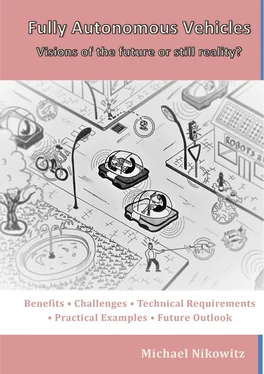





 Autonomous cars no longer exist merely in the minds of children and science fiction writers. They are real and will be on roads sooner than you think. Michael Nikowitz
Autonomous cars no longer exist merely in the minds of children and science fiction writers. They are real and will be on roads sooner than you think. Michael Nikowitz


